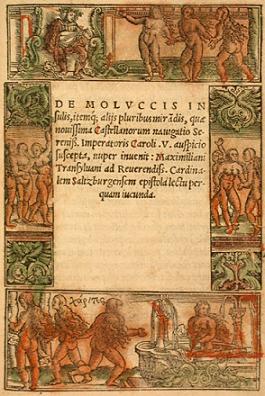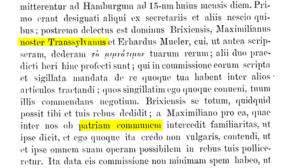Maximilianus Transylvanus facts for kids
Maximilian van Sevenbergen, also known as Maximilianus Transylvanus, was an important person who worked for Emperor Charles V. He is best known for writing the first published story about the amazing journey of Ferdinand Magellan and Juan Sebastián Elcano. This was the first time anyone sailed all the way around the world, from 1519 to 1522!
Maximilian wrote his account, called De Moluccis Insulis, after talking to the sailors who survived the trip on the ship Victoria. His book is a very important source of information about this historic voyage.
Contents
Who Was Maximilianus Transylvanus?
Maximilian van Sevenbergen was born between 1485 and 1490 and passed away in 1538 in Brussels. He was a courtier, which means he worked closely with the Emperor. His family name, "Transylvanus," might make you think he was from Transylvania. However, historians believe he was actually from Flanders, a region in what is now Belgium.
His Family Background
Maximilian came from a well-known family. His grandfather, Steven van Sevenbergen, might have been from a village called Zevenbergen in the Netherlands. His father, Lucas van Sevenbergen, was a goldsmith and lived in Brussels. Lucas also worked for Emperor Maximilian I as a special assistant and seal engraver.
Lucas and his wife, Jeanne Meerte, had three children:
- 1) Maximilian van Sevenbergen (our main subject).
- 2) Barbele van Sevenbergen, who married a secretary of the Emperor.
- 3) Anna van Sevenbergen, who passed away young.
Maximilian van Sevenbergen married Françoise de Haro in 1521. Her father was a merchant who was friends with Ferdinand Magellan. After Françoise passed away, Maximilian married Catherine de Mol in 1531. They had two daughters:
- 1) Jeanne van Sevenbergen, who became a lady of important estates. She married a knight who was an ambassador for Charles V.
- 2) Marie van Sevenbergen, who married a leader in a rebellion in the Low Countries.
Maximilian also had two children who were recognized as his, even though they were born outside of marriage:
- 3) Maximilian van Sevenbergen, born around 1523.
- 4) Jeanne van Sevenbergen, born around 1527.
His Homes and Castles
Maximilianus Transylvanus had a grand Italian-style palace built in Brussels. It was so beautiful that a poet even wrote Latin poems about it! In 1537, he also bought the historic Bouchout Castle near Brussels.

Where Was Maximilianus From?
There are some interesting stories and debates about where Maximilianus Transylvanus really came from.
Evidence for Flemish Roots
Many scholars believe Maximilianus was from Flanders, not Transylvania. Here's why:
- He married Frances, whose uncle, Christopher de Haro, helped fund Magellan's trip. Her father ran a business in Antwerp.
- Maximilianus had strong connections to Brussels, where he lived and died.
- A Latin poem he wrote suggests his "Transylvanus" name came from a diplomatic trip he took to Transylvania.
- Important people of his time, like Sigismund von Herberstein and Konrad Peutinger, called him by names like "Sibenpergen" or "Sybenberger." These names clearly refer to his real family name, "van Sevenbergen." This name might also be linked to the Dutch town "Zevenbergen," which is similar to the German name for Transylvania, Siebenbürgen.
The Transylvanian Origin Story
Some people believed Maximilianus was from Transylvania. This idea might have come from a misunderstanding or a legend. For example, some old books incorrectly said he was the son of a powerful archbishop, which wasn't true.
However, there is one interesting piece of evidence that supports a Transylvanian connection. A famous scholar and bishop named Nicolaus Olahus wrote a letter in 1534. In this letter, he called Maximilianus "our Transylvanian Maximilianus." Olahus said they were close friends because they shared a "common fatherland." Nicolaus Olahus himself was born in Hermannstadt (now Sibiu), which is in Transylvania. This suggests a strong bond based on a shared heritage.
Maximilianus's Writings
Maximilianus Transylvanus was not just a courtier; he was also a writer.
His Early Work
In 1520, Maximilianus published a book in Latin. It described the grand event where Charles I of Spain was chosen as the Holy Roman Emperor in 1519. At this time, Maximilianus was already working as a personal secretary for Charles V. He even traveled with the Emperor.
The Famous Magellan Account
As secretary to Emperor Charles V, Maximilianus had a special opportunity. When Magellan's only surviving ship, the Victoria, returned to Spain in September 1522, he interviewed the sailors who had completed the journey. These survivors included Juan Sebastián Elcano, Francisco Albo, and Hernando de Bustamante.
Maximilianus was eager to become a famous writer. He wrote his account, De Moluccis Insulis, as a letter to Matthäus Lang von Wellenburg, a powerful cardinal. This cardinal had actually suggested that Maximilianus interview the sailors.
Maximilianus dated his letter October 24, 1522. It was quickly sent to a printer in Cologne, and the first edition of De Moluccis Insulis was printed in January 1523. Even with wars going on, his book quickly spread. It was reprinted in Paris in July 1523 and again in Rome in November 1523.
About De Moluccis Insulis
Maximilianus Transylvanus was very interested in Magellan's journey around the world. His book was the first to tell Europe about this incredible feat.
However, it's important to remember that he wrote it very quickly. He also trusted everything the surviving crew members told him without checking it too much.
The official story of the expedition was written by Antonio Pigafetta, who was also a survivor. But Pigafetta's full account wasn't published until much later, in 1800! So, for a long time, Maximilianus's book was the main way people learned about the first trip around the globe.
Maximilianus's book also shared some interesting details and even gossip from the voyage. For example, he wrote about a "shameful and foul conspiracy" (a mutiny) among the Spanish officers. He also had a different idea than Pigafetta about who was responsible for a terrible event in Cebu in the Philippines. Maximilianus said it was João Serrão who mistreated Magellan's former slave, Enrique of Malacca, leading to a massacre. Pigafetta, however, blamed Duarte Barbosa.
His book also included a good description of how spices were grown. He wrote that "The natives share groves of this tree among themselves, just as we do vineyards."
You can find copies of the first edition of his work in famous libraries like the Beinecke Library at Yale University.
See also
In Spanish: Maximiliano Transilvano para niños



